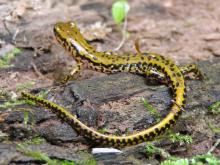Reptiles and Amphibians
Media

Species Types
Scientific Name
Eurycea lucifuga
Description
The cave salamander is a common amphibian of the Ozark Plateau. It lives in caves, springs, and rocky streams. Recognize it by its normally bright orange skin dotted with dark brown or black spots.
Media

Species Types
Scientific Name
Ambystoma annulatum
Description
The ringed salamander is secretive, spending most of its time under logs or rocks or in burrows. The rings never completely encircle the body. It occurs in the southwestern and central Missouri Ozarks, and in the river hills of the Missouri River in eastern Missouri.
Media

Species Types
Scientific Name
Ambystoma maculatum
Description
The spotted salamander is one of Missouri's six species of mole salamanders. It is slate black with two irregular rows of rounded yellow spots from the head onto the tail. It occurs in forests in the southern two-thirds of the state.
Media

Species Types
Scientific Name
Eurycea longicauda longicauda (eastern dark-sided salamander) and E. l. melanopleura (dark-sided salamander)
Description
The eastern long-tailed salamander and closely related dark-sided salamander are agile and can escape predators by using their tails for quick jumps. They live in the southern and eastern parts of Missouri.
Media

Species Types
Scientific Name
Ambystoma tigrinum
Description
Tiger salamanders occur statewide. They spend most of their time underground, often in burrows made by small mammals or under logs and rocks. Your best chance of seeing a tiger salamander is at night after a heavy rain.
See Also
About Reptiles and Amphibians in Missouri
Missouri’s herptiles comprise 43 amphibians and 75 reptiles. Amphibians, including salamanders, toads, and frogs, are vertebrate animals that spend at least part of their life cycle in water. They usually have moist skin, lack scales or claws, and are ectothermal (cold-blooded), so they do not produce their own body heat the way birds and mammals do. Reptiles, including turtles, lizards, and snakes, are also vertebrates, and most are ectothermal, but unlike amphibians, reptiles have dry skin with scales, the ones with legs have claws, and they do not have to live part of their lives in water.





















